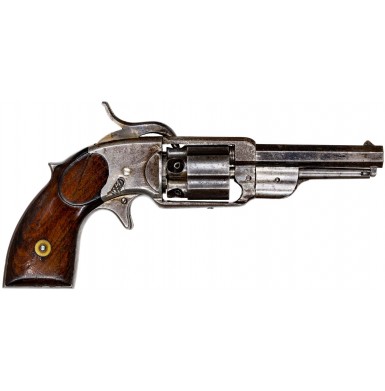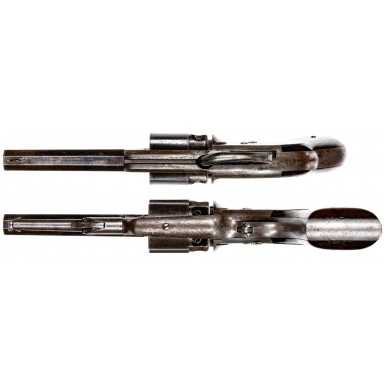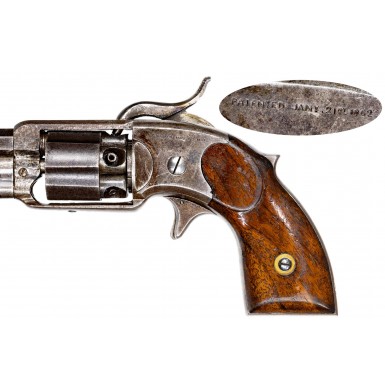This is a VERY GOOD+ to NEAR FINE example of an extremely scarce American percussion revolver with an interesting lineage. The Alsop Navy percussion revolver was produced in a Middletown, CT factory that was owned by Joseph W. Alsop and was based on patents granted to Charles R. Alsop and Charles H. Alsop, Joseph’s sons. Charles R. Alsop was granted eight firearms related patents during his career, including four related to revolvers, two in 1860, one in 1861 and one in 1862. Charles H. received only two firearms patents, one related to revolvers in 1861 and one for a breechloading firearm in 1868. At first glance, there are clearly some similarities between the Alsop family of revolvers, both the smaller .31 “Pocket” and the larger .36 “Navy” variants and the Savage Revolving Arms Company’s “Navy” revolver.
The guns of both makers have an awkwardly shaped grip, with very thin, oddly shaped grip panels and an odd hump or spur near the top of the backstrap. They also both have center-hung hammers that ignite the percussion cap through a hole in the top of the frame of the revolver. In fact, all three of the gun makers in the Alsop family (Joseph W and sons Charles R. & Charles H.) were listed as members of the Savage Revolving Firearms corporation in the Savage incorporation papers, so it makes sense that some design similarities would exist between the revolvers of the two firms. Approximately 500 Alsop “Navy” revolvers were produced, likely between 1862 and 1863. While most references indicate that the pistols were serial numbered from 1 up, it is more likely that they were numbered consecutively with the Alsop Pocket revolvers, as I have formerly sold a pocket revolver that was numbered 758 and estimates place pocket model production at only 300 pieces!
The Alsop revolvers featured a complicated and somewhat fragile single action lock work. The cylinder engaged a rotating plate at its rear that indexes the cylinder. This system is similar to the system used on some of the Allen & Wheelock side hammer revolvers. The Alsop firm only produced arms during the early 1860s, and Joseph, who owned the Middleton factory, sold the property, and moved to New York at the conclusion of the Civil War.
While many firearms historians note that the Savage Navy was revolver was a descendant of the Alsop revolvers, the patent dates applicable to the guns do not bear this out. Clearly the Alsop’s were involved with the Savage firearms company and at least one Alsop patent drawing is included with the patent information filed on the Savage Navy, but the Alsop revolver seems to be a somewhat less complicated and more refined version of the Savage, and not vice versa. The Alsop revolvers were produced as both a .31 caliber “Pocket” model and a .36 caliber as a “Navy” model. The Pocket Revolver was primarily produced with a 6-shot handgun with a round cylinder, while the Navy Revolver was produced with a 5-shot cylinder. The early Navy revolvers had fluted cylinders while the later production “standard models” had round cylinders. The early, “1st Model” Navy revolvers also featured a sliding safety device on the right side of the frame, above the trigger sheath. Both variants were single action percussion revolvers with a central loading lever mounted under their octagonal barrels. The standard finish was blued with a color casehardened hammer and loading lever and two-piece smooth walnut grips. The Alsop Navy revolvers were manufactured with barrels that ranged from a nominal 3 ½” to 6 ½” in length, in 1” increments. It was not uncommon for those dimensions to vary marginally, by as much +/- 1/8”.
This Alsop Navy percussion revolver is in VERY GOOD+ to NEAR FINE overall condition. The revolver is extremely well marked throughout with the typical Alsop manufacturing marks and patent information. The top of the barrel is marked in two lines:
C.R. ALSOP MIDDLETOWN CONN.
PATENTED JULY 17th. AUGUST 7th. 1860 MAY 14th. 1861
The left side of the frame is marked in a single line below the hammer PATENTED JANY 21ST 1862
and the cylinder is marked in one of its flutes, in two lines:
C.H. ALSOP PATENTED
NOV. 26th 1861
The revolver is serial numbered 78, and this number is found on the bottom of the grip frame, inside the frame (concealed by the grips), under the barrel (concealed by the loading lever), on the rear face of each chamber of the cylinder, on the loading lever plunger and in pencil inside the left grip panel, although the marking is barely legible.
As previously noted, this particular Alsop Navy Revolver is in VERY GOOD+ to NEAR FINE condition overall. The revolver is one of the early production “1st Model” examples with a fluted five-shot cylinder and the frame mounted safety on the right side. The revolver has the shortest standard barrel length for this model, measuring 3 ½” in length. The revolver retains the original brass blade front sight at the end of the barrel, and the rear sight is a simple groove in the top strap of the revolver. The gun retains strong edges, and the markings remain clear and fully legible. The gun retains about 20% of its original blued finish overall, with the majority of the finish on the barrel. The barrel retains about 30%+ of its original blue, with the loss due primarily to flaking, wear and fading. Much of this appears to be the result of real world carry and use. There are also some lightly scattered minor surface scratches and dings in the metal, which are also apparently from handling and use. There is some lightly scattered surface oxidation mixed in the remaining finish on the barrel, along with some freckled areas of minor surface roughness and some pinpricking around the muzzle. The bore of the pistol rates about GOOD+ and is mostly bright with scattered oxidation and discoloration. The bore retains visible rifling but is evenly pitted along its length with the pitting ranging from light to more moderate in some places. The fluted cylinder retains some traces of its original blued finish, which has also flaked and worn and has mixed with a moderately oxidized plum brown patina. The cylinder shows some evenly distributed light surface roughness with some pitting around the cylinder face and the percussion cone (nipple) recesses. The cones all appear to be original to the revolver, but all show some battering and at least light to moderate wear and flattening. The frame also retains only minute traces of its original blued finish, and has a mostly smooth brownish-gray patina, with the grip frame and backstrap having a similar appearance. The frame is mostly smooth and shows only some very lightly scattered pinpricking and scattered surface oxidation. The top strap shows some moderate surface oxidation as well as some evenly distributed pinpricking and light pitting from the erosion typical from 19th century percussion cap flash. The hammer retains some strong traces of its original case coloring, with the loading lever having a mostly mottled and oxidized brownish patina that only hints at traces of the original coloring. The loading lever functions smoothly and locks into position crisply. Being an early production revolver, this gun has the 1st model sliding safety on the right side of the frame. The safety works as it should, but the safety has been modified by the cutting of crude checkering into the face of the operating lever. The part appears original, simply cut with the checkering to make it easier to grip and slide up and down to engage and disengage respectively. To use the safety, the revolver is placed on half cock and then the safety is slid up, which locks the hammer into the half cock notch and prevents the hammer from being cocked. Sliding the safety back down allows the hammer to be fully operated as normal. The revolver remains fully functional and times, indexes and locks up as it should when the hammer is cocked, and releases correctly when the trigger is pulled. The original grips are present and as noted the left grip is numbered to the gun. They are a lovely pair of figured walnut, and like the Savage grip panels, they are quite thin and prone to breakage. The grips are in about VERY GOOD condition. The grips are solid and complete with only a small, repaired crack about 1 ¼” in length at the center top of the right grip. The grips retain good edges and have not been sanded but do show some minor wear along the high edges of their sides. Otherwise, the grips remain mostly smooth, with only some scattered light bumps, dings, and mars present.
It is not often that you have the opportunity to own a revolver that is one of only 500 manufactured during the height of the American Civil War. In addition, this is one of the first 100 guns produced of this model, with the rarely encountered frame mounted safety and the early production fluted cylinder. This is a rarely encountered Civil War era percussion revolver, which is missing from many Civil War revolver collections, except the most advanced ones. When encountered they are often well worn and have heavily damaged grips. This is a very nice complete, original, and unmolested example of a scarce, secondary martial, percussion revolver that would be a fantastic addition to any advanced collection of Civil War era handguns.
SOLD











